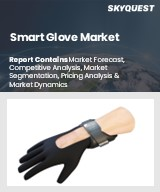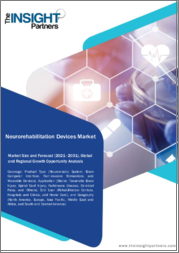
|
시장보고서
상품코드
1819952
신경재활 기기 시장 보고서 : 제품 유형, 용도, 최종사용자, 지역별(2025-2033년)Neurorehabilitation Devices Market Report by Product Type, Application, End User, and Region 2025-2033 |
||||||
세계 신경재활 기기 시장 규모는 2024년 20억 달러에 달했습니다. 향후 IMARC Group은 2033년에는 45억 달러에 달하고, 2025-2033년 연평균 성장률(CAGR)은 9.2%를 보일 것으로 예측했습니다.
신경재활 기기는 뇌 및 중추신경계(CNS) 검사에 사용되는 기기를 말합니다. 일반적으로 사용되는 기기에는 신경 로봇 시스템, 비침습적 뇌 자극 장치, 신경 인공장기, 뇌-컴퓨터 인터페이스, 웨어러블 기기 등이 있습니다. 이 장비들은 환자의 신경계 질환, 장애, 부상을 진단하고 치료하는 데 도움을 줍니다. 또한, 파킨슨병, 심혈관계 뇌졸중 등 신경질환으로 인한 운동기술의 재학습과 최적의 회복을 돕습니다. 그 결과, 신경재활 기기는 다양한 클리닉, 인지치료, 연구기관, 헬스케어 센터 등에서 폭넓게 사용되고 있습니다.
신경재활 기기 시장 동향 :
다발성 경화증, 파킨슨병, 뇌성마비 등 신경질환의 유병률 증가는 시장 성장을 가속하는 주요 요인 중 하나입니다. 또한, 이러한 질병에 취약한 노령 인구 증가는 시장 성장을 가속하고 있습니다. 신경재활 기기는 사지의 움직임을 회복시키기 위해 척수의 여러 섬유에 다양한 전기신호를 전개하여 사지의 움직임을 회복시키기 위한 보조장치입니다. 또한 가상현실(VR)을 통한 재활 활동의 게임화, 로봇공학, 인공지능(AI) 등 회복을 촉진하기 위한 다양한 기술 발전이 또 다른 성장 촉진요인으로 작용하고 있습니다. 이에 따라 척수 손상 치료에 새로운 다전극 자극을 활용하는 것도 시장 성장에 기여하고 있습니다. 기타 요인으로는 대중의 의료비 지출 능력 증가, 광범위한 연구개발(R&D) 활동 등이 시장을 더욱 견인할 것으로 예측됩니다.
본 보고서에서 다룬 주요 질문
- 2024년 세계의 신경재활 기기 시장 규모는?
- 세계의 신경재활 기기 시장 2025-2033년 성장률 전망은?
- 세계의 신경재활 기기 시장을 주도하는 주요 요인은?
- 코로나19가 세계의 신경재활 기기 시장에 미치는 영향은?
- 세계의 신경재활 기기 시장에서의 제품 유형별 분류는?
- 세계의 신경재활 기기 시장에서의 용도별 분류는?
- 세계 신경재활 기기 시장의 최종 사용자별 시장 현황은?
- 세계 신경재활 기기 시장의 주요 지역은?
- 세계 신경재활 기기 시장의 주요 업체는?
목차
제1장 서문
제2장 조사 범위와 조사 방법
- 조사 목적
- 이해관계자
- 데이터 소스
- 1차 정보
- 2차 정보
- 시장 추정
- 보텀업 접근
- 톱다운 접근
- 조사 방법
제3장 주요 요약
제4장 서론
제5장 세계의 신경재활 기기 시장
- 시장 개요
- 시장 실적
- COVID-19의 영향
- 시장 예측
제6장 시장 분석 : 제품 유형별
- 신경 로봇 기기
- 웨어러블 기기
- 비침습성 자극 기기
- 브레인 컴퓨터 인터페이스
제7장 시장 분석 : 용도별
- 뇌졸중
- 다발성 경화증
- 파킨슨병
- 뇌성마비
- 기타
제8장 시장 분석 : 최종사용자별
- 병원 및 진료소
- 인지 케어 센터
- 기타
제9장 시장 분석 : 지역별
- 북미
- 미국
- 캐나다
- 아시아태평양
- 중국
- 일본
- 인도
- 한국
- 호주
- 인도네시아
- 기타
- 유럽
- 독일
- 프랑스
- 영국
- 이탈리아
- 스페인
- 러시아
- 기타
- 라틴아메리카
- 브라질
- 멕시코
- 기타
- 중동 및 아프리카
제10장 SWOT 분석
제11장 밸류체인 분석
제12장 Porter의 Five Forces 분석
제13장 가격 분석
제14장 경쟁 구도
- 시장 구조
- 주요 기업
- 주요 기업 개요
- Biometrics Ltd
- Bioness Inc.
- Bionik Laboratories Corp
- BioXtreme Ltd.
- Boston Scientific Corporation
- Ectron Ltd
- Ekso Bionics
- Hocoma AG(DIH International Limited)
- Kinestica
- Kinova Inc.
- Medtronic plc
- Saebo Inc
- Tyromotion GmbH
The global neurorehabilitation devices market size reached USD 2.0 Billion in 2024. Looking forward, IMARC Group expects the market to reach USD 4.5 Billion by 2033, exhibiting a growth rate (CAGR) of 9.2% during 2025-2033.
Neurorehabilitation devices refer to the equipment used for examination of the brain and central nervous system (CNS). Some of the commonly used devices include neurorobotic systems, non-invasive brain stimulators, neuroprosthetics, brain-computer interfaces and wearable devices. These devices assist in the diagnosis and treatment of a disease, disorder or injury in the nervous system of the patient. They facilitate in re-learning motor skills and optimal recovery from neurological disorders, such as Parkinson's disease, and cardiovascular stroke. As a result, neurorehabilitation devices find extensive applications across various clinics, cognitive care and research institutes and healthcare centers.
Neurorehabilitation Devices Market Trends:
The increasing prevalence of neurological diseases, such as multiple sclerosis, Parkinson's disease and cerebral palsy, is one of the key factors driving the market growth. Moreover, the rising geriatric population, which is more susceptible to such ailments, is providing a thrust to the growth of the market. Neurorehabilitation devices aid in deploying diversified electric signals to multiple fibers of the spinal cord for the recovery of limb movements. Additionally, various technological advancements, such as the gamification of rehabilitation activities through virtual reality (VR), robotics and artificial intelligence (AI), that aid in promoting recovery are acting as other growth-inducing factors. In line with this, the utilization of novel multi-electrode stimulation for the treatment of spinal cord injuries is also contributing to the market growth. Other factors, including rising healthcare expenditure capacities of the masses, along with extensive research and development (R&D) activities, are anticipated to drive the market further.
Key Market Segmentation:
Breakup by Product Type:
- Neurorobotic Devices
- Wearable Devices
- Non-Invasive Stimulators
- Brain-Computer Interface
Breakup by Application:
- Stroke
- Multiple Sclerosis
- Parkinson's Disease
- Cerebral Palsy
- Others
Breakup by End User:
- Hospitals and Clinics
- Cognitive Care Centers
- Others
Breakup by Region:
- North America
- United States
- Canada
- Asia-Pacific
- China
- Japan
- India
- South Korea
- Australia
- Indonesia
- Others
- Europe
- Germany
- France
- United Kingdom
- Italy
- Spain
- Russia
- Others
- Latin America
- Brazil
- Mexico
- Others
- Middle East and Africa
Competitive Landscape:
The competitive landscape of the industry has also been examined along with the profiles of the key players being Biometrics Ltd, Bioness Inc., Bionik Laboratories Corp, BioXtreme Ltd., Boston Scientific Corporation, Ectron Ltd, Ekso Bionics, Hocoma AG (DIH International Limited), Kinestica, Kinova Inc., Medtronic plc, Saebo Inc and Tyromotion GmbH.
Key Questions Answered in This Report
- 1.What was the size of the global neurorehabilitation devices market in 2024?
- 2.What is the expected growth rate of the global neurorehabilitation devices market during 2025-2033?
- 3.What are the key factors driving the global neurorehabilitation devices market?
- 4.What has been the impact of COVID-19 on the global neurorehabilitation devices market?
- 5.What is the breakup of the global neurorehabilitation devices market based on the product type?
- 6.What is the breakup of the global neurorehabilitation devices market based on the application?
- 7.What is the breakup of the global neurorehabilitation devices market based on the end user?
- 8.What are the key regions in the global neurorehabilitation devices market?
- 9.Who are the key players/companies in the global neurorehabilitation devices market?
Table of Contents
1 Preface
2 Scope and Methodology
- 2.1 Objectives of the Study
- 2.2 Stakeholders
- 2.3 Data Sources
- 2.3.1 Primary Sources
- 2.3.2 Secondary Sources
- 2.4 Market Estimation
- 2.4.1 Bottom-Up Approach
- 2.4.2 Top-Down Approach
- 2.5 Forecasting Methodology
3 Executive Summary
4 Introduction
- 4.1 Overview
- 4.2 Key Industry Trends
5 Global Neurorehabilitation Devices Market
- 5.1 Market Overview
- 5.2 Market Performance
- 5.3 Impact of COVID-19
- 5.4 Market Forecast
6 Market Breakup by Product Type
- 6.1 Neurorobotic Devices
- 6.1.1 Market Trends
- 6.1.2 Market Forecast
- 6.2 Wearable Devices
- 6.2.1 Market Trends
- 6.2.2 Market Forecast
- 6.3 Non-Invasive Stimulators
- 6.3.1 Market Trends
- 6.3.2 Market Forecast
- 6.4 Brain-Computer Interface
- 6.4.1 Market Trends
- 6.4.2 Market Forecast
7 Market Breakup by Application
- 7.1 Stroke
- 7.1.1 Market Trends
- 7.1.2 Market Forecast
- 7.2 Multiple Sclerosis
- 7.2.1 Market Trends
- 7.2.2 Market Forecast
- 7.3 Parkinson's Disease
- 7.3.1 Market Trends
- 7.3.2 Market Forecast
- 7.4 Cerebral Palsy
- 7.4.1 Market Trends
- 7.4.2 Market Forecast
- 7.5 Others
- 7.5.1 Market Trends
- 7.5.2 Market Forecast
8 Market Breakup by End User
- 8.1 Hospitals and Clinics
- 8.1.1 Market Trends
- 8.1.2 Market Forecast
- 8.2 Cognitive Care Centers
- 8.2.1 Market Trends
- 8.2.2 Market Forecast
- 8.3 Others
- 8.3.1 Market Trends
- 8.3.2 Market Forecast
9 Market Breakup by Region
- 9.1 North America
- 9.1.1 United States
- 9.1.1.1 Market Trends
- 9.1.1.2 Market Forecast
- 9.1.2 Canada
- 9.1.2.1 Market Trends
- 9.1.2.2 Market Forecast
- 9.1.1 United States
- 9.2 Asia-Pacific
- 9.2.1 China
- 9.2.1.1 Market Trends
- 9.2.1.2 Market Forecast
- 9.2.2 Japan
- 9.2.2.1 Market Trends
- 9.2.2.2 Market Forecast
- 9.2.3 India
- 9.2.3.1 Market Trends
- 9.2.3.2 Market Forecast
- 9.2.4 South Korea
- 9.2.4.1 Market Trends
- 9.2.4.2 Market Forecast
- 9.2.5 Australia
- 9.2.5.1 Market Trends
- 9.2.5.2 Market Forecast
- 9.2.6 Indonesia
- 9.2.6.1 Market Trends
- 9.2.6.2 Market Forecast
- 9.2.7 Others
- 9.2.7.1 Market Trends
- 9.2.7.2 Market Forecast
- 9.2.1 China
- 9.3 Europe
- 9.3.1 Germany
- 9.3.1.1 Market Trends
- 9.3.1.2 Market Forecast
- 9.3.2 France
- 9.3.2.1 Market Trends
- 9.3.2.2 Market Forecast
- 9.3.3 United Kingdom
- 9.3.3.1 Market Trends
- 9.3.3.2 Market Forecast
- 9.3.4 Italy
- 9.3.4.1 Market Trends
- 9.3.4.2 Market Forecast
- 9.3.5 Spain
- 9.3.5.1 Market Trends
- 9.3.5.2 Market Forecast
- 9.3.6 Russia
- 9.3.6.1 Market Trends
- 9.3.6.2 Market Forecast
- 9.3.7 Others
- 9.3.7.1 Market Trends
- 9.3.7.2 Market Forecast
- 9.3.1 Germany
- 9.4 Latin America
- 9.4.1 Brazil
- 9.4.1.1 Market Trends
- 9.4.1.2 Market Forecast
- 9.4.2 Mexico
- 9.4.2.1 Market Trends
- 9.4.2.2 Market Forecast
- 9.4.3 Others
- 9.4.3.1 Market Trends
- 9.4.3.2 Market Forecast
- 9.4.1 Brazil
- 9.5 Middle East and Africa
- 9.5.1 Market Trends
- 9.5.2 Market Breakup by Country
- 9.5.3 Market Forecast
10 SWOT Analysis
- 10.1 Overview
- 10.2 Strengths
- 10.3 Weaknesses
- 10.4 Opportunities
- 10.5 Threats
11 Value Chain Analysis
12 Porters Five Forces Analysis
- 12.1 Overview
- 12.2 Bargaining Power of Buyers
- 12.3 Bargaining Power of Suppliers
- 12.4 Degree of Competition
- 12.5 Threat of New Entrants
- 12.6 Threat of Substitutes
13 Price Analysis
14 Competitive Landscape
- 14.1 Market Structure
- 14.2 Key Players
- 14.3 Profiles of Key Players
- 14.3.1 Biometrics Ltd
- 14.3.1.1 Company Overview
- 14.3.1.2 Product Portfolio
- 14.3.2 Bioness Inc.
- 14.3.2.1 Company Overview
- 14.3.2.2 Product Portfolio
- 14.3.3 Bionik Laboratories Corp
- 14.3.3.1 Company Overview
- 14.3.3.2 Product Portfolio
- 14.3.3.3 Financials
- 14.3.4 BioXtreme Ltd.
- 14.3.4.1 Company Overview
- 14.3.4.2 Product Portfolio
- 14.3.5 Boston Scientific Corporation
- 14.3.5.1 Company Overview
- 14.3.5.2 Product Portfolio
- 14.3.5.3 Financials
- 14.3.5.4 SWOT Analysis
- 14.3.6 Ectron Ltd
- 14.3.6.1 Company Overview
- 14.3.6.2 Product Portfolio
- 14.3.7 Ekso Bionics
- 14.3.7.1 Company Overview
- 14.3.7.2 Product Portfolio
- 14.3.8 Hocoma AG (DIH International Limited)
- 14.3.8.1 Company Overview
- 14.3.8.2 Product Portfolio
- 14.3.9 Kinestica
- 14.3.9.1 Company Overview
- 14.3.9.2 Product Portfolio
- 14.3.10 Kinova Inc.
- 14.3.10.1 Company Overview
- 14.3.10.2 Product Portfolio
- 14.3.11 Medtronic plc
- 14.3.11.1 Company Overview
- 14.3.11.2 Product Portfolio
- 14.3.11.3 Financials
- 14.3.11.4 SWOT Analysis
- 14.3.12 Saebo Inc
- 14.3.12.1 Company Overview
- 14.3.12.2 Product Portfolio
- 14.3.13 Tyromotion GmbH
- 14.3.13.1 Company Overview
- 14.3.13.2 Product Portfolio
- 14.3.13.3 Financials
- 14.3.1 Biometrics Ltd



















